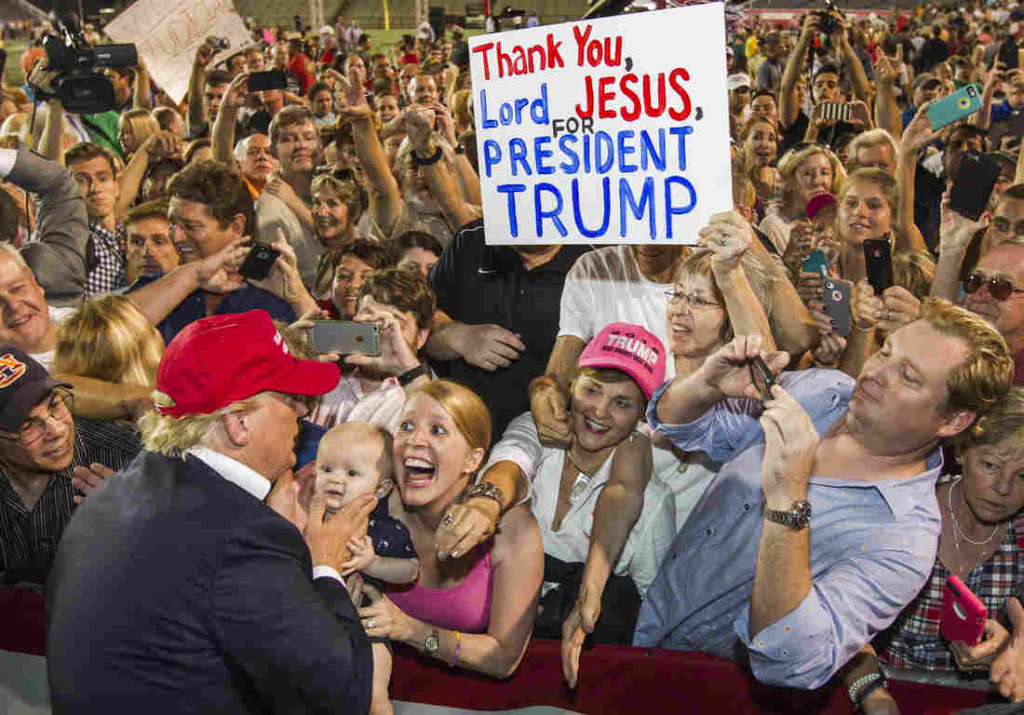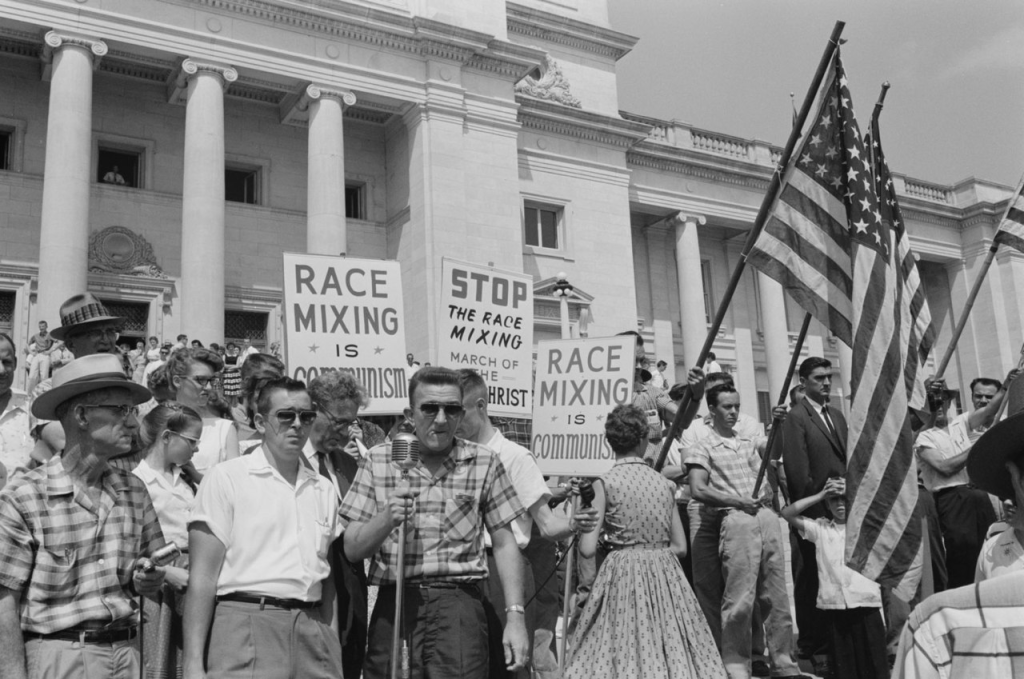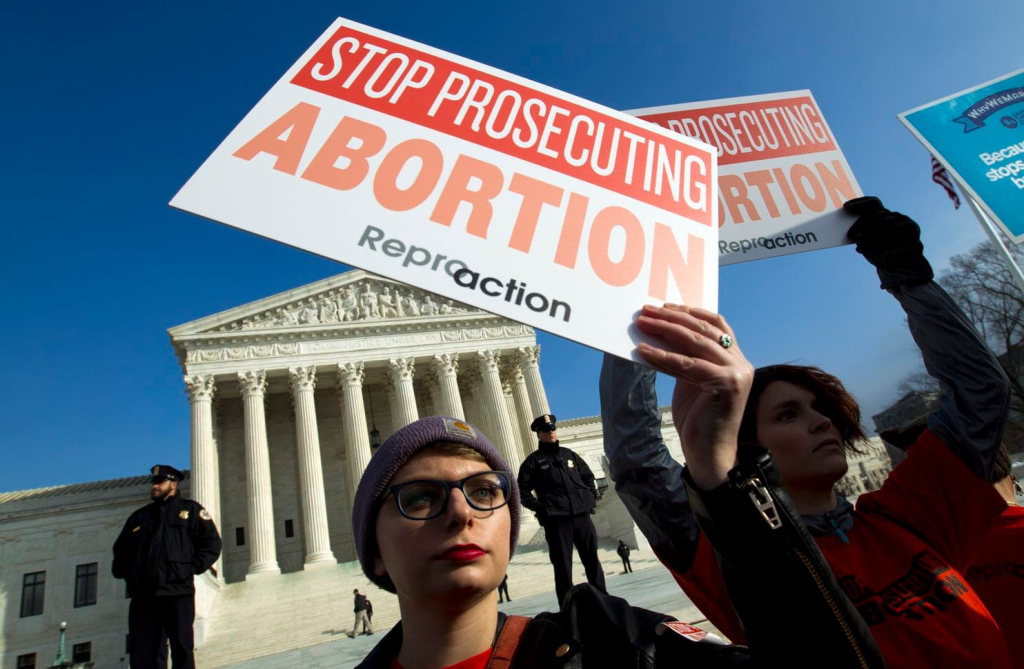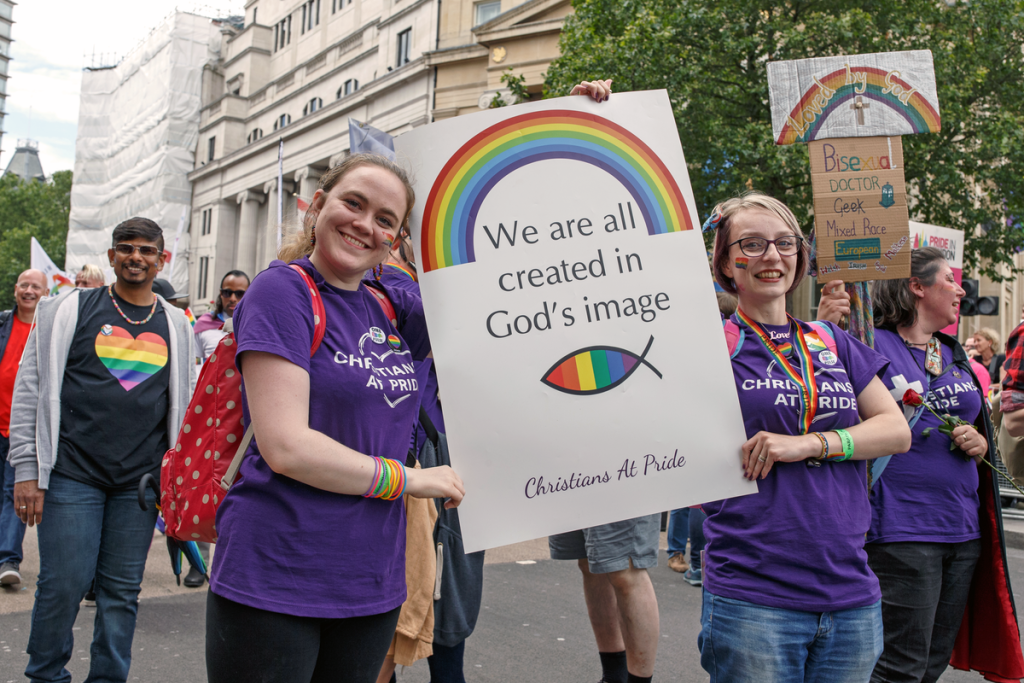Segregation Not Reproductive Rights was the Founding Issue of the Religious
I found the two articles below fascinating for the light they shed on America’s Evangelical Right. Like many people I’ve always assumed that Protestant Christian Fundamentalists had always been opposed to abortion. Today opposition to abortion is the litmus test of the Christian Right. However it was not always so.

The key issue for the Christian Right historically was race. However it became politically embarrassing and inconvenient from the late 1970’s onwards to wage a war against Black children and for segregation. That was the context for the move from opposition to school integration to opposition to legal abortions.
However one should be under no illusions that Evangelical Christians, 81% of whom voted for Donald Trump, whose morality has hardly been that of a pious Christian, is still motivated by issues of race, which Trump personifies.

The Bible Belt and the Ku Klux Klan always overlapped. Segregation was seen as ordained by god and it was practised with an evangelical fervour by the private Christian Bob Jones University in South Carolina. The Bob Jones University, which gave an honorary doctorate to Ian Paisley, the leader of the sectarian Free Presbyterian Church and founder of the Democratic Unionist Party in Northern Ireland, was the subject of battles with the US Inland Revenue Service, which refused to grant charitable tax status to institutions which refused to admit Black students. Even when the University did begin to admit non-White students it strictly forbade interracial dating and the idea of miscegenation.

You can see Statement about Race at BJU for the University’s explanation in 2008 recanting its past. However its notable for its self-serving nature, blaming ‘American culture’ rather than their interpretation of the Christian Gospel. They say that:
‘For almost two centuries American Christianity, including BJU in its early stages, was characterized by the segregationist ethos of American culture.
See also: The Klan, White Christianity, and the Past and Present by Randall J. Stephens.
Race, Not Abortion Was the Founding Issue of the Religious Right
February 12, 2019 Margery Eagan The Boston Globe

Henrietta Hilton, front left, and her fellow students in their ninth grade classroom in Summerton, S.C., in 1954. The classroom was at the center of a controversy which led to one of four cases involving “separate but equal” facilities.
Here are some facts that might surprise you.
In 1971, two years before Roe v. Wade legalized abortion, the biggest white evangelical group in America, the Southern Baptist Convention, supported its legalization. The group continued that support through much of the 1970s. And the late Jerry Falwell, founder of the Moral Majority, did not give his first antiabortion speech until 1978, five years after Roe.
Though opposition to abortion is what many think fuelled the powerful conservative white evangelical right, 81 percent of whom voted for Donald Trump, it was really school integration, according to Randall Balmer, chairman of the religion department at Dartmouth.
The US Supreme Court ruled public school segregation unconstitutional in 1954. In 1976 it ruled against segregated private schools. Then courts went after the tax exemptions of these private all-white Southern schools, or so-called segregation academies, like Falwell’s Liberty Christian Academy.

The late Paul Weyrich, whom Balmer called the organizational genius behind the religious right, had long tried to mobilize evangelical voters around some hot-button issue: feminism, school prayer, pornography, abortion. But nothing lit a fire like the federal government’s threat to all-white schools. Only in 1979, a full six years after Roe, did Weyrich urge evangelical leaders to also crusade against abortion, Balmer said in an interview. That was, after all, a far more palatable, acceptable crusade, one with a seeming high moral purpose, unlike a race-based crusade against black children.
I mention all this because Politico recently reported on the increasing power of religious ultra-conservatives in Trump’s Department of Health and Human Services, and what that could soon mean for further restrictions on abortion, birth control, and gay and transgender protections.
“This administration is focused on recognizing one set of religious beliefs,” Gretchen Borchelt of the National Women’s Law Center told Politico. But why the one set of beliefs so out of step with the rest of America? Though 70 percent of white evangelicals want abortion illegal, the majority of other religious groups, including mainline Protestants, black Protestants, and Catholics, do not.

This raises unsettling questions: How much of antiabortion rhetoric is really about the unborn, and how much is a convenient and even cynical cover for white evangelicals to support, as they did, a white supremacist like Roy Moore, in Alabama, or Trump himself, leader of the American birther movement and defender of neo-Nazis in Charlottesville, Va.?
Balmer’s scholarship on the racial underpinnings of the religious right — and the link between the antiabortion movement and a certain political agenda — is more than familiar to a group of Americans who overwhelmingly rejected both Moore and Trump. That would be black evangelicals.
Among them is Cornell William Brooks, past national president of the NAACP and a fourth-generation African Methodist Episcopal Church minister who was arrested last year during an Alabama sit-in to protest Trump’s then nominee for attorney general, Jeff Sessions.

“For Christian conservatives who put abortion at the top of their list, the challenge becomes objecting to the loss of life in the womb but also objecting to the loss of life beyond the womb,” said Brooks, now a visiting professor at Boston University. “You cannot segregate your compassion.
“Wring your hands over the child lost in the womb as well as the loss of the child Tamir Rice,” the 12-year-old gunned down by a police officer in Cleveland. “Be concerned about discrimination, immigration, police misconduct, voter suppression, misogyny on the lips of the president, black lives mattering, all lives mattering,” Brooks said.
It is worth noting that some of the same white evangelical leaders who just gave a pass to Trump for an alleged affair with a porn star either supported him or kept mum after Charlottesville and after his attacks on immigrants from what he called “shithole countries.”
Said Brooks, “We are not being candid with ourselves if we don’t admit race has a lot to do with all this.”
Said Balmer, “The religious right is coming back to the founding principles of a movement based in racism.”
Margery Eagan is cohost of WGBH’s “Boston Public Radio.”
The Real Origins of the Religious Right
They’ll tell you it was abortion. Sorry, the historical record’s clear: It was segregation.
By RANDALL BALMER
May 27, 2014
Randall Balmer is the Mandel family professor in the arts and sciences at Dartmouth College. His most recent book is Redeemer: The Life of Jimmy Carter.
One of the most durable myths in recent history is that the religious right, the coalition of conservative evangelicals and fundamentalists, emerged as a political movement in response to the U.S. Supreme Court’s 1973 Roe v. Wade ruling legalizing abortion. The tale goes something like this: Evangelicals, who had been politically quiescent for decades, were so morally outraged by Roe that they resolved to organize in order to overturn it.
This myth of origins is oft repeated by the movement’s leaders. In his 2005 book, Jerry Falwell, the firebrand fundamentalist preacher, recounts his distress upon reading about the ruling in the Jan. 23, 1973, edition of the Lynchburg News:
“I sat there staring at the Roe v. Wade story,” Falwell writes, “growing more and more fearful of the consequences of the Supreme Court’s act and wondering why so few voices had been raised against it.”
Evangelicals, he decided, needed to organize.
Some of these anti- Roe crusaders even went so far as to call themselves “new abolitionists,” invoking their antebellum predecessors who had fought to eradicate slavery.
But the abortion myth quickly collapses under historical scrutiny. In fact, it wasn’t until 1979—a full six years after Roe—that evangelical leaders, at the behest of conservative activist Paul Weyrich, seized on abortion not for moral reasons, but as a rallying-cry to deny President Jimmy Carter a second term. Why? Because the anti-abortion crusade was more palatable than the religious right’s real motive: protecting segregated schools. So much for the new abolitionism.
***
Today, evangelicals make up the backbone of the pro-life movement, but it hasn’t always been so. Both before and for several years after Roe, evangelicals were overwhelmingly indifferent to the subject, which they considered a “Catholic issue.”
In 1968, for instance, a symposium sponsored by the Christian Medical Society and Christianity Today, the flagship magazine of evangelicalism, refused to characterize abortion as sinful, citing “individual health, family welfare, and social responsibility” as justifications for ending a pregnancy.
In 1971, delegates to the Southern Baptist Convention in St. Louis, Missouri, passed a resolution encouraging “Southern Baptists to work for legislation that will allow the possibility of abortion under such conditions as rape, incest, clear evidence of severe fetal deformity, and carefully ascertained evidence of the likelihood of damage to the emotional, mental, and physical health of the mother.” The convention, hardly a redoubt of liberal values, reaffirmed that position in 1974, one year after Roe, and again in 1976.
When the Roe decision was handed down, W. A. Criswell, the Southern Baptist Convention’s former president and pastor of First Baptist Church in Dallas, Texas—also one of the most famous fundamentalists of the 20th century—was pleased: “I have always felt that it was only after a child was born and had a life separate from its mother that it became an individual person,” he said, “and it has always, therefore, seemed to me that what is best for the mother and for the future should be allowed.”
Although a few evangelical voices, including Christianity Today magazine, mildly criticized the ruling, the overwhelming response was silence, even approval. Baptists, in particular, applauded the decision as an appropriate articulation of the division between church and state, between personal morality and state regulation of individual behavior. “Religious liberty, human equality and justice are advanced by the Supreme Court abortion decision,” wrote W. Barry Garrett of Baptist Press.
***
So what then were the real origins of the religious right? It turns out that the movement can trace its political roots back to a court ruling, but not Roe v. Wade. In May 1969, a group of African-American parents in Holmes County, Mississippi, sued the Treasury Department to prevent three new whites-only K-12 private academies from securing full tax-exempt status, arguing that their discriminatory policies prevented them from being considered “charitable” institutions. The schools had been founded in the mid-1960s in response to the desegregation of public schools set in motion by the Brown v. Board of Education decision of 1954. In 1969, the first year of desegregation, the number of white students enrolled in public schools in Holmes County dropped from 771 to 28; the following year, that number fell to zero.
In Green v. Kennedy (David Kennedy was secretary of the treasury at the time), decided in January 1970, the plaintiffs won a preliminary injunction, which denied the “segregation academies” tax-exempt status until further review. In the meantime, the government was solidifying its position on such schools. Later that year, President Richard Nixon ordered the Internal Revenue Service to enact a new policy denying tax exemptions to all segregated schools in the United States. Under the provisions of Title VI of the Civil Rights Act, which forbade racial segregation and discrimination, discriminatory schools were not—by definition—“charitable” educational organizations, and therefore they had no claims to tax-exempt status; similarly, donations to such organizations would no longer qualify as tax-deductible contributions.
On June 30, 1971, the United States District Court for the District of Columbia issued its ruling in the case, now Green v. Connally (John Connally had replaced David Kennedy as secretary of the Treasury). The decision upheld the new IRS policy:
“Under the Internal Revenue Code, properly construed, racially discriminatory private schools are not entitled to the Federal tax exemption provided for charitable, educational institutions, and persons making gifts to such schools are not entitled to the deductions provided in case of gifts to charitable, educational institutions.”
***
Paul Weyrich, the late religious conservative political activist and co-founder of the Heritage Foundation, saw his opening.
In the decades following World War II, evangelicals, especially white evangelicals in the North, had drifted toward the Republican Party—inclined in that direction by general Cold War anxieties, vestigial suspicions of Catholicism and well-known evangelist Billy Graham’s very public friendship with Dwight Eisenhower and Richard Nixon. Despite these predilections, though, evangelicals had largely stayed out of the political arena, at least in any organized way. If he could change that, Weyrich reasoned, their large numbers would constitute a formidable voting bloc—one that he could easily marshal behind conservative causes.
“The new political philosophy must be defined by us [conservatives] in moral terms, packaged in non-religious language, and propagated throughout the country by our new coalition,”
Weyrich wrote in the mid-1970s. “When political power is achieved, the moral majority will have the opportunity to re-create this great nation.”
Weyrich believed that the political possibilities of such a coalition were unlimited. “The leadership, moral philosophy, and workable vehicle are at hand just waiting to be blended and activated,” he wrote. “If the moral majority acts, results could well exceed our wildest dreams.”
But this hypothetical “moral majority” needed a catalyst—a standard around which to rally. For nearly two decades, Weyrich, by his own account, had been trying out different issues, hoping one might pique evangelical interest: pornography, prayer in schools, the proposed Equal Rights Amendment to the Constitution, even abortion. “I was trying to get these people interested in those issues and I utterly failed,” Weyrich recalled at a conference in 1990.
The Green v. Connally ruling provided a necessary first step: It captured the attention of evangelical leaders , especially as the IRS began sending questionnaires to church-related “segregation academies,” including Falwell’s own Lynchburg Christian School, inquiring about their racial policies. Falwell was furious. “In some states,” he famously complained, “It’s easier to open a massage parlor than a Christian school.”
One such school, Bob Jones University—a fundamentalist college in Greenville, South Carolina—was especially obdurate. The IRS had sent its first letter to Bob Jones University in November 1970 to ascertain whether or not it discriminated on the basis of race. The school responded defiantly: It did not admit African Americans.
Although Bob Jones Jr., the school’s founder, argued that racial segregation was mandated by the Bible, Falwell and Weyrich quickly sought to shift the grounds of the debate, framing their opposition in terms of religious freedom rather than in defense of racial segregation. For decades, evangelical leaders had boasted that because their educational institutions accepted no federal money (except for, of course, not having to pay taxes) the government could not tell them how to run their shops—whom to hire or not, whom to admit or reject. The Civil Rights Act, however, changed that calculus.
Bob Jones University did, in fact, try to placate the IRS—in its own way. Following initial inquiries into the school’s racial policies, Bob Jones admitted one African-American, a worker in its radio station, as a part-time student; he dropped out a month later. In 1975, again in an attempt to forestall IRS action, the school admitted blacks to the student body, but, out of fears of miscegenation, refused to admit unmarried African-Americans. The school also stipulated that any students who engaged in interracial dating, or who were even associated with organizations that advocated interracial dating, would be expelled.
The IRS was not placated. On January 19, 1976, after years of warnings—integrate or pay taxes—the agency rescinded the school’s tax exemption.
For many evangelical leaders, who had been following the issue since Green v. Connally, Bob Jones University was the final straw. As Elmer L. Rumminger, longtime administrator at Bob Jones University, told me in an interview, the IRS actions against his school “alerted the Christian school community about what could happen with government interference” in the affairs of evangelical institutions. “That was really the major issue that got us all involved.”
***
Weyrich saw that he had the beginnings of a conservative political movement, which is why, several years into President Jimmy Carter’s term, he and other leaders of the nascent religious right blamed the Democratic president for the IRS actions against segregated schools—even though the policy was mandated by Nixon, and Bob Jones University had lost its tax exemption a year and a day before Carter was inaugurated as president. Falwell, Weyrich and others were undeterred by the niceties of facts. In their determination to elect a conservative, they would do anything to deny a Democrat, even a fellow evangelical like Carter, another term in the White House.
But Falwell and Weyrich, having tapped into the ire of evangelical leaders, were also savvy enough to recognize that organizing grassroots evangelicals to defend racial discrimination would be a challenge. It had worked to rally the leaders, but they needed a different issue if they wanted to mobilize evangelical voters on a large scale.
By the late 1970s, many Americans—not just Roman Catholics—were beginning to feel uneasy about the spike in legal abortions following the 1973 Roe decision. The 1978 Senate races demonstrated to Weyrich and others that abortion might motivate conservatives where it hadn’t in the past. That year in Minnesota, pro-life Republicans captured both Senate seats (one for the unexpired term of Hubert Humphrey) as well as the governor’s mansion. In Iowa, Sen. Dick Clark, the Democratic incumbent, was thought to be a shoo-in: Every poll heading into the election showed him ahead by at least 10 percentage points. On the final weekend of the campaign, however, pro-life activists, primarily Roman Catholics, leafleted church parking lots (as they did in Minnesota), and on Election Day Clark lost to his Republican pro-life challenger.
In the course of my research into Falwell’s archives at Liberty University and Weyrich’s papers at the University of Wyoming, it became very clear that the 1978 election represented a formative step toward galvanizing everyday evangelical voters. Correspondence between Weyrich and evangelical leaders fairly crackles with excitement. In a letter to fellow conservative Daniel B. Hales, Weyrich characterized the triumph of pro-life candidates as “true cause for celebration,” and Robert Billings, a cobelligerent, predicted that opposition to abortion would “pull together many of our ‘fringe’ Christian friends.” Roe v. Wade had been law for more than five years.
Weyrich, Falwell and leaders of the emerging religious right enlisted an unlikely ally in their quest to advance abortion as a political issue: Francis A. Schaeffer—a goateed, knickers-wearing theologian who was warning about the eclipse of Christian values and the advance of something he called “secular humanism.” Schaeffer, considered by many the intellectual godfather of the religious right, was not known for his political activism, but by the late 1970s he decided that legalized abortion would lead inevitably to infanticide and euthanasia, and he was eager to sound the alarm. Schaeffer teamed with a pediatric surgeon, C. Everett Koop, to produce a series of films entitled Whatever Happened to the Human Race? In the early months of 1979, Schaeffer and Koop, targeting an evangelical audience, toured the country with these films, which depicted the scourge of abortion in graphic terms—most memorably with a scene of plastic baby dolls strewn along the shores of the Dead Sea. Schaeffer and Koop argued that any society that countenanced abortion was captive to “secular humanism” and therefore caught in a vortex of moral decay.
Between Weyrich’s machinations and Schaeffer’s jeremiad, evangelicals were slowly coming around on the abortion issue. At the conclusion of the film tour in March 1979, Schaeffer reported that Protestants, especially evangelicals, “have been so sluggish on this issue of human life, and Whatever Happened to the Human Race? is causing real waves, among church people and governmental people too.”
By 1980, even though Carter had sought, both as governor of Georgia and as president, to reduce the incidence of abortion, his refusal to seek a constitutional amendment outlawing it was viewed by politically conservative evangelicals as an unpardonable sin. Never mind the fact that his Republican opponent that year, Ronald Reagan, had signed into law, as governor of California in 1967, the most liberal abortion bill in the country. When Reagan addressed a rally of 10,000 evangelicals at Reunion Arena in Dallas in August 1980, he excoriated the “unconstitutional regulatory agenda” directed by the IRS “against independent schools,” but he made no mention of abortion. Nevertheless, leaders of the religious right hammered away at the issue, persuading many evangelicals to make support for a constitutional amendment outlawing abortion a litmus test for their votes.
Carter lost the 1980 election for a variety of reasons, not merely the opposition of the religious right. He faced a spirited challenge from within his own party; Edward M. Kennedy’s failed quest for the Democratic nomination undermined Carter’s support among liberals. And because Election Day fell on the anniversary of the Iran Hostage Crisis, the media played up the story, highlighting Carter’s inability to secure the hostages’ freedom. The electorate, once enamored of Carter’s evangelical probity, had tired of a sour economy, chronic energy shortages and the Soviet Union’s renewed imperial ambitions.
After the election results came in, Falwell, never shy to claim credit, was fond of quoting a Harris poll that suggested Carter would have won the popular vote by a margin of 1 percent had it not been for the machinations of the religious right. “I knew that we would have some impact on the national elections,” Falwell said, “but I had no idea that it would be this great.”
Given Carter’s political troubles, the defection of evangelicals may or may not have been decisive. But it is certainly true that evangelicals, having helped propel Carter to the White House four years earlier, turned dramatically against him, their fellow evangelical, during the course of his presidency. And the catalyst for their political activism was not, as often claimed, opposition to abortion. Although abortion had emerged as a rallying cry by 1980, the real roots of the religious right lie not the defense of a fetus but in the defense of racial segregation.
***
The Bob Jones University case merits a postscript. When the school’s appeal finally reached the Supreme Court in 1982, the Reagan administration announced that it planned to argue in defense of Bob Jones University and its racial policies. A public outcry forced the administration to reconsider; Reagan backpedaled by saying that the legislature should determine such matters, not the courts. The Supreme Court’s decision in the case, handed down on May 24, 1983, ruled against Bob Jones University in an 8-to-1 decision. Three years later Reagan elevated the sole dissenter, William Rehnquist, to chief justice of the Supreme Court.